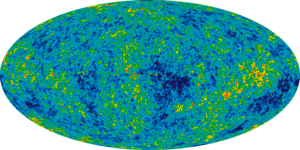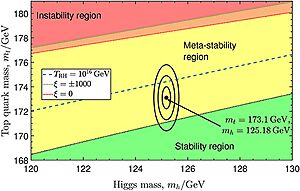False vacuum decay facts for kids
| Physical cosmology | ||||||||||||||
 |
||||||||||||||
| Universe · Big Bang Age of the universe Timeline of the Big Bang Ultimate fate of the universe
|
||||||||||||||

Imagine a ball resting in a dip on a bumpy hill. This dip is like a false vacuum in space. It's a state where the universe has some energy, but it's not the lowest possible energy. It's like the ball is stable for a while, but it could roll down to an even lower dip if given a push.
This "false vacuum" is a special kind of vacuum. It's pretty stable, but not perfectly stable. Scientists call this "metastable". It could stay this way for a very, very long time. But eventually, it might change to a more stable state. This change is called false vacuum decay.
One idea for how this decay might happen is called "bubble nucleation". Imagine a tiny spot in the universe suddenly reaching a more stable state. This "bubble" would then grow and spread, changing everything it touches.
Contents
What is a True vs. False Vacuum?
Understanding Vacuum States
A vacuum is usually thought of as empty space. But in physics, it's a space with the least possible energy. Even in a vacuum, there are tiny fields of energy.
A true vacuum is like the lowest valley on a landscape. It's the most stable energy state possible. Our universe is usually thought to be in a true vacuum.
A false vacuum is different. It's like a small dip on a hill, not the very bottom. It's a stable spot, but there's a deeper, more stable spot it could fall into.
What Happens if the Universe Decays?
Big Changes for the Universe
If our universe is in a false vacuum, and it decays into a true vacuum, big things could happen. The effects could be huge.
- Some scientists think it could change the basic forces of nature. These are the forces that hold everything together.
- It could change tiny particles and even the structures they form.
- This might mean that matter as we know it would be destroyed.
- In some extreme ideas, the universe could even collapse.
However, some ideas suggest that galaxies and stars might survive. Even life could continue, but in a very different way. The exact outcome depends on how different the true vacuum is from the false one.
Early Universe and Inflation
Many theories suggest that something called cosmic inflation happened right after the Big Bang. This was a super-fast expansion of the universe. Some scientists think this inflation was caused by a false vacuum decaying into a true vacuum.
- Alan Guth first suggested this idea for cosmic inflation. He thought inflation could end when bubbles of true vacuum formed.
- Later, Andrei Linde and, separately, Andreas Albrecht and Paul Steinhardt suggested a "slow roll inflation." In this idea, the change is smoother, without sudden bubbles.
In 2014, some scientists in China suggested that the universe might have started from nothing. They thought it could have begun with tiny quantum wiggles in a false vacuum. This would have created an expanding bubble of true vacuum.
Types of Vacuum Decay
Electroweak Vacuum Decay
Scientists have studied the stability of the electroweak interaction. This is one of the four basic forces. They look at the masses of the Higgs boson and the heaviest fermion (a type of particle).
- The discovery of the top quark in 1995 and the Higgs boson in 2012 helped scientists test these ideas.
- Since 2012, the electroweak force is seen as a possible candidate for being in a "metastable" state. This means it's in a false vacuum.
- The diagrams show how stable the electroweak vacuum might be. It depends on the masses of the Higgs boson and top quark.
- Current measurements suggest our universe might be in this metastable state.
If this is true, a bubble of true vacuum could form. It would then spread across the universe at nearly the speed of light. This would happen many billions of years from now.
Other Possible Decays
Scientists have also thought about other ways a vacuum could decay:
- It could change to a state with less Casimir effect. This might make protons unstable.
- It could change to a vacuum where neutrinos have a different mass.
- It could change to a vacuum with no dark energy.
How Bubbles Form and Grow
Bubble Nucleation Process
When a false vacuum decays, a lower-energy true vacuum forms. This happens through "bubble nucleation".
- A tiny bubble of true vacuum appears.
- The edges of this bubble are like "domain walls". They have energy, like a stretched rubber band.
- For a bubble to grow, it must reach a certain "critical size".
- Smaller bubbles tend to shrink and disappear. Larger bubbles will grow and expand.
- Tiny bubbles can grow past this critical size through something called quantum tunnelling. This is a quantum trick where particles can pass through energy barriers.
Once a bubble grows past its critical size, its walls start to speed outward. They quickly reach almost the speed of light. The bubble itself doesn't create gravity effects. This is because the negative energy inside is balanced by the energy of its expanding wall.
Where Bubbles Might Start
Some environments might help bubbles form. They could lower the energy barrier needed for a bubble to appear.
Black Holes as Starting Points
- In 2015, a study suggested that black holes could act as "nucleation seeds." This means they could greatly increase the chance of vacuum decay.
- If tiny primordial black holes exist, they might have triggered a collapse long ago.
- However, a 2017 study suggested that bubbles might collapse into primordial black holes, not start from them.
- A 2019 study found that fast-spinning black holes might actually make false vacuums more stable.
Some people worried that experiments like the Large Hadron Collider (LHC) could create mini black holes. They feared this might trigger a vacuum decay.
- However, scientists say this is very unlikely. Cosmic rays hit Earth's atmosphere with much higher energies than the LHC. If mini black holes could cause decay, it would have happened already.
- In 2021, some scientists suggested that the area between two colliding black holes could create true vacuum bubbles. These bubbles might then form tiny black holes that evaporate.
How Bubbles Spread
The Expanding Bubble Wall
A bubble's wall spreads outward at nearly the speed of light. This wall has a certain thickness. This thickness depends on the energy difference between the false and true vacuums.
- When elementary particles hit this wall, they might decay into other particles or even black holes.
- Sometimes, if the decay leads to very heavy particles, it can create a stable bubble of false vacuum. This is called a Fermi ball.
- Other multi-particle objects, called Q-balls, can also be stable for a while. But eventually, they would decay into black holes or true-vacuum particles.
False Vacuum Decay in Stories
The idea of a false vacuum decay is sometimes used in science fiction. It's a dramatic way to imagine the end of the world.
- Vacuum States (1988) by Geoffrey A. Landis
- Time (2000) by Stephen Baxter
- Schild's Ladder (2002) by Greg Egan
- Edge (2008) by Koji Suzuki
- Poseidon's Wake (2015) by Alastair Reynolds
Images for kids
See also
 In Spanish: Falso vacío para niños
In Spanish: Falso vacío para niños
- Eternal inflation
- Supercooling
- Superheating
- Void




